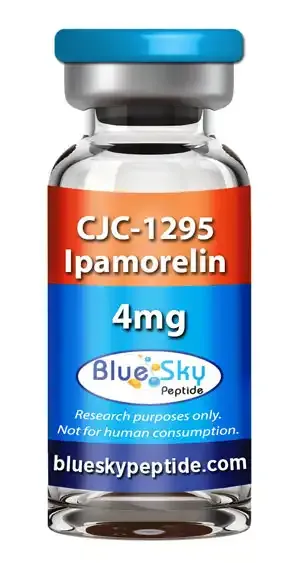60% Off Your Order*
Our Biggest Sale of the Year!!

Availability: In stock

| Unit Size | 4 mg/vial |
| Unit Quantity | 1 vial |
| Purity (Mass Spectrometry and UV) | 99.75% |
| Sequence (CJC 1295 NO DAC) | H-Tyr-D-Ala-Asp-Ala-Ile-Phe-Thr-Gln-Ser-Tyr-Arg-Lys-Val-Leu-Ala-Gln-Leu- Ser-Ala-Arg-Lys-Leu--Leu-Gln-Asp-Ile-Leu-Ser-Arg-NH2 |
| Sequence (IPAMORELIN) | Aib-His-D-2-Nal-D-Phe-Lys-NH2 |
| Molecular Formula (CJC 1295 NO DAC) |
C152H252N44O42 |
| Molecular Formula (IPAMORELIN) | C38H49N9O5 |
| Appearance | Lyophilized White Powder |
| Source | Chemical Synthesis |
| Storage | Lyophilized Blend CJC 1295 NO DAC with Ipamorelin is stable at roomTemperature for 90 days, however it is best to store in a freezer below - 8c for any extended period of time. |
| Terms | The products we offer are intended for laboratory research use only. Please familiarize yourself with our terms of service prior to ordering. |
Blend CJC-1295 NO DAC with Ipamorelin is a powerful combination of two synthetic peptides: CJC-1295 and ipamorelin. CJC-1295 is a synthetic analog of growth hormone-releasing hormone (GHRH) that binds to the GHRH receptor, stimulating the release of growth hormone. It consists of 30 amino acids with a molecular weight of 3647.16 g/mol. This formulation is CJC-1295 without DAC, meaning it does not contain the drug affinity complex (DAC) used to prolong its half-life.(1)
Ipamorelin is a synthetic hexapeptide that stimulates growth hormone release through the growth hormone secretagogue receptor (GHS-R) in the anterior pituitary gland. Although its structure differs from ghrelin, ipamorelin mimics some functions of ghrelin. It consists of 6 amino acids with a molecular weight of 711.39 g/mol.(2,3) Together, CJC-1295 and ipamorelin enhance growth hormone release by targeting two different receptors, allowing researchers to investigate their synergistic effects.
Scientific in vitro and animal studies have shown that both peptides promote bone health and stimulate insulin release through insulin-like growth factor 1 (IGF-1). Ipamorelin has been associated with significant increases in bone mineral content in animal models, while CJC-1295 supports bone formation by stimulating osteoblast activity through IGF-1.(4,5) Both peptides have also demonstrated the ability to boost insulin production in pancreatic tissue via IGF-1 mechanisms in animal studies.
Blue Sky Peptide’s Blend CJC-1295 NO DAC with Ipamorelin is available as a white lyophilized powder, with a concentration of 4 mg per vial. This product is intended exclusively for in vitro scientific research and is not for human use or consumption.
All findings referenced here are based on in vitro research or animal models. This product is strictly for laboratory use to explore its biochemical and physiological effects under controlled experimental conditions. Additional studies are necessary to determine its safety and efficacy beyond the research setting.
References: